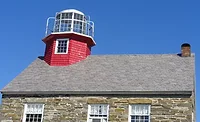Project Profile: Roofing Above Water
Contractors overcome weather conditions off of Lake Michigan’s coastline to restore historic lighthouse
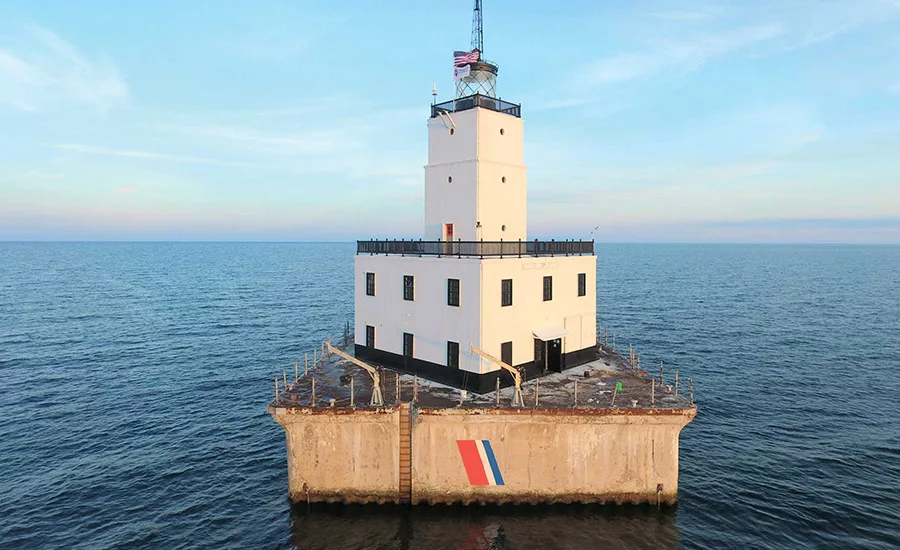
Roofing can take you to very interesting and isolating places, and for the team at Doyle Inc. Roofing of Cheboygan, Mich., it included a historic yet rapidly-eroding structure standing three stories above Lake Michigan.
The North Manitou Shoal Lighthouse sits offshore on the northern end of the second largest of the five Great Lakes. It’s about nine miles from the famed Sleeping Bear Dunes National Lakeshore along Michigan’s Southern Peninsula and sits roughly a mile from North Manitou Island. That location, between the two land masses, makes the active lighthouse critically important for ships moving through the busy channel. The structure, completed in 1935, has helped thousands of vessels navigate a shallow shoal in the Manitou Passage. The United States Coast Guard operated it with a staffed crew until the installation of automated navigation controls in 1980.
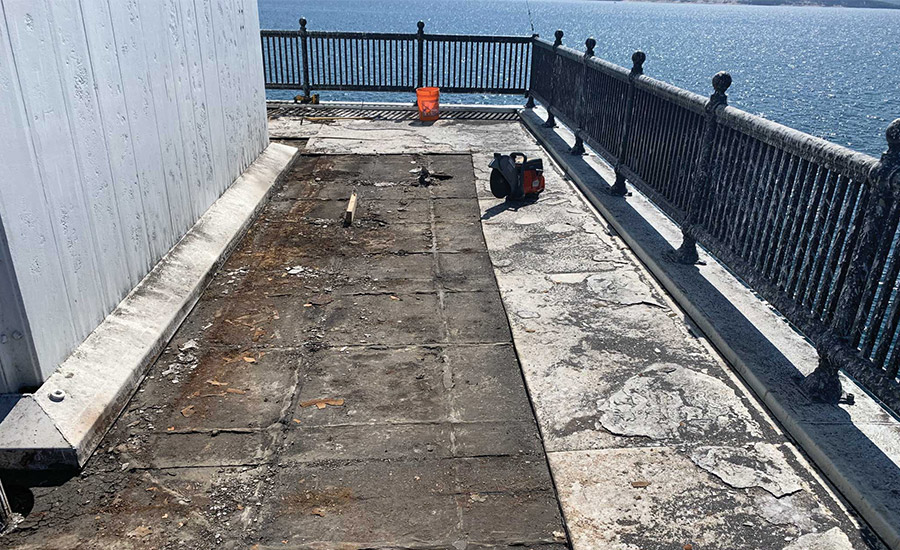 BEFORE: Years of little or no maintenance compromised the abandoned lighthouse’s concrete and tar roof, threatening the historic structure’s interior.
BEFORE: Years of little or no maintenance compromised the abandoned lighthouse’s concrete and tar roof, threatening the historic structure’s interior.
Though in use, it sat vacant for decades with little maintenance. By the time it made the National Register of Historic Places in 2005, the lighthouse interior decayed to the point of concern to local preservationists actively trying to save the landmark. Eleven years later, a nonprofit group called the North Manitou Light Keepers purchased the entire structure from the government at auction.
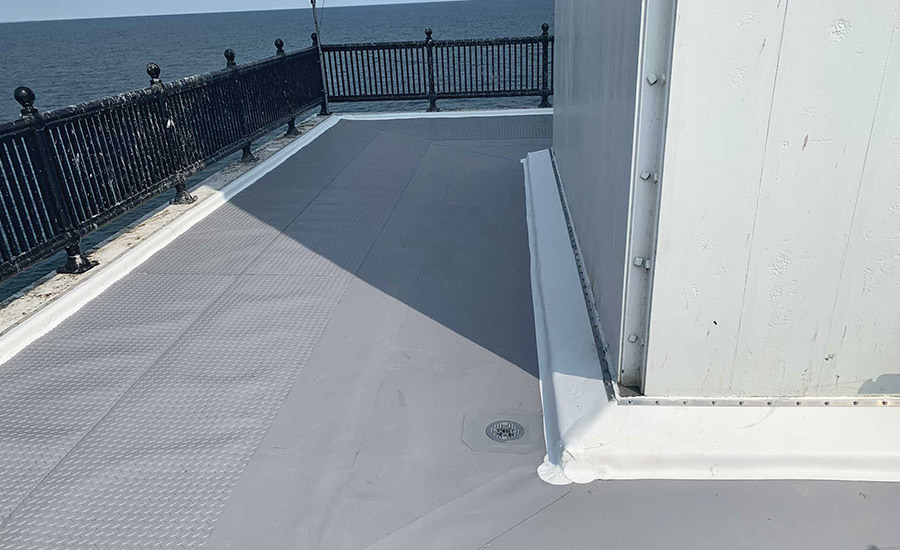 AFTER: The new roof consists of both mechanically-fastened and fully-adhered half-inch-thick 100 psi polyiso insulation with gray VersiFleece® TPO membrane on the deck and white VersiWeld® TPO membrane for the wall flashing.
AFTER: The new roof consists of both mechanically-fastened and fully-adhered half-inch-thick 100 psi polyiso insulation with gray VersiFleece® TPO membrane on the deck and white VersiWeld® TPO membrane for the wall flashing.
Since 2016, the group of proud locals and amateur historians have been on a mission to restore and preserve the lighthouse, to share it with the public today and for generations in the future. That required a lot of fundraising and physical work on the structure’s interior and exterior before public tours began in the summer of 2021. To start, the outside of the lighthouse received a hazmat cleanup, was sandblasted and wholly repainted. Windows were rebuilt and restored on multiple levels; the lantern glass was replaced.
Following these cosmetic upgrades, the nonprofit formed an ambitious plan to address the last area of water intrusion on the mid-level deck, where water caused significant structural damage to the interior living quarters.
“When the government mothballed the lighthouse in 1980, 3/8-inch steel plates were installed on the deck to prevent water intrusion and secure the structure for long-term preservation. These plates were badly deteriorated and delaminated and had to be removed,” said Dave McWilliam, chief of restoration and operations for North Manitou Light Keepers.
Once the 7,300 pounds of steel were cut and removed, it was time to replace the aged concrete and tar roof.
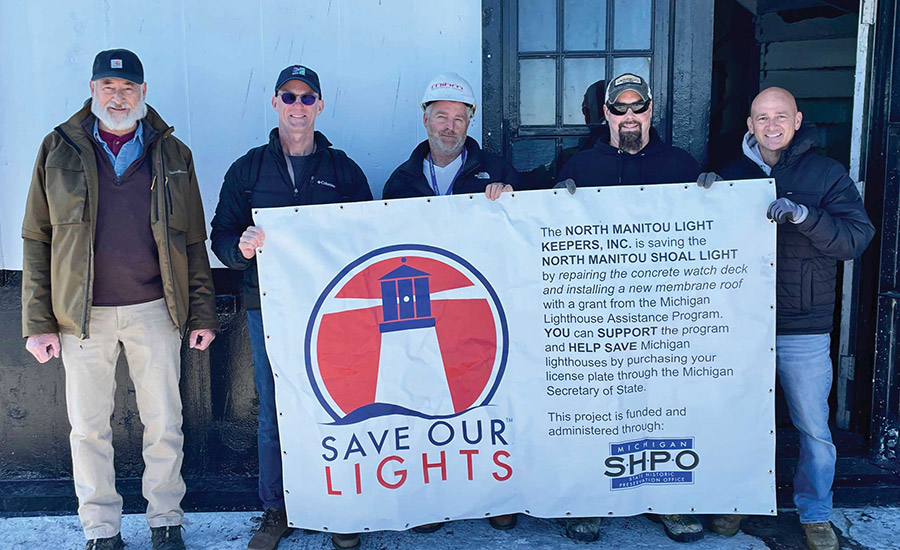 Members of the nonprofit North Manitou Light Keepers kick-started preservation plans and funding for the historic lighthouse, including an entire roof replacement.
Members of the nonprofit North Manitou Light Keepers kick-started preservation plans and funding for the historic lighthouse, including an entire roof replacement.
Unique Challenges Require Unique Plan
To call this project distinctive would be an understatement for most roofers. Consider the job itself; the roof is more of a walkway surface for people that use the third level of the lighthouse, and there are two rooftop drains and wall flashing on all sides.
The experts at Doyle Roofing recommended a hybrid assembly featuring a Versico roofing membrane. The new roof would consist of both mechanically fastened and fully adhered half-inch-thick 100 psi polyiso insulation with gray VersiFleece® TPO membrane on the deck and white VersiWeld® TPO membrane for the wall flashing.
Installers said the system provides excellent protection against harsh weather and lakefront conditions. State architects that oversaw the design agreed. The project has a 15-year warranty, and Versico’s gray color option replicates the historic lighthouse’s original aesthetics. A grant from the Michigan Lighthouse Assistance Program assisted with funding for the new membrane roof.
“We are very pleased with the final product. The work from Doyle Roofing was high-quality, and the support and warranty from Versico was appreciated,” McWilliam said. “We also appreciated the coordination and cooperation from Doyle and Versico to ensure that the work was done to historic standards and met the approval of the state architect.”
That’s high praise considering that simply arriving at the jobsite was a challenge. For five days, Doyle Roofing crews traveled nearly 20 total miles by boat from the nearest marina with all their materials to reach the lighthouse. Other obstacles they overcame included:
- There was no electrical service or a functional plumbing system.
- Delivery cranes only reached the first deck, which required carrying all materials up two flights of stairs.
- The wind and weather on Lake Michigan can be unpredictable and change quickly, requiring schedule flexibility to accommodate unforeseen delays and work cancellations.
- The project had to have zero negative environmental impact on the air and water quality, which state officials closely monitored.
- With a spot on the National Register of Historic Places, all work had to comply with the Department of Interior’s Historic Preservation Standards, and specifications were approved and monitored by Michigan’s State Historic Preservation Office.
- All this, coupled with the unique location and environment, hiked the price two to four times what it would cost to complete a comparable project on land.
“All parties worked well together to ensure a successful outcome of this project,” McWilliam said. “We have an aesthetically pleasing and long-lasting product which will serve the needs of the lighthouse for many years to come.”
Looking for a reprint of this article?
From high-res PDFs to custom plaques, order your copy today!




